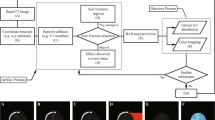Summary
Chronological changes in diffuse brain swelling and brain oedema were studied in repeated CT studies following a closed head injury. These findings were compared with changes in intracranial pressure (ICP). The grades of diffuse brain swelling were classified into mild, moderate and marked according to the CT findings. Planimetry of low density areas of brain oedema was carried out on repeated CT images. Diffuse brain swelling was recognized in 71 of patients shortly after the head injury and subsided within days 3–5. Brain oedema first appeared 24 hours post injury and did not reach its maximum size and distribution before days 5–8. Thus, these two events can be clearly separated. The intracranial pressure reflected the course of the brain swelling and was not very high during the presence of maximum oedema.
Similar content being viewed by others
References
Bruce, D. A., Langfitt, T. W., Miller, J. D., Schutz, H., Vaphalahti, M. P., Stanek, A., Goldberg, H. I., Regional cerebral blood flow, intracranial pressure, and brain metabolism in comatose patients. J. Neurosurg.38 (1973), 131–144.
Bruce, D. A., Alavi, A., Bilaniuk, L., Dolinskas, C., Obrist, W., Uzzell, B., Diffuse cerebral swelling following head injuries in children; the syndrome of “malignant brain edema”. J. Neurosurg.54 (1981), 170–178.
Clifton, G. L., Grossmann, R. G., Makeal, M. E., Miner, M. E., Handel, S., Sadhu, V., Neurological course and correlated computerized tomography findings after severe closed head injury. J. Neurosurg.52 (1980), 611–624.
Corales, R. I., Miller, J. D., Becker, D. D., Intracranial pressure and brain water content in acute graded experimental cerebral trauma. In: Intracranial Pressure IV (Shulman, K.et al, eds.), pp. 280–283. Berlin-Heidelberg-New York: Springer. 1980.
French, B. N., Dublin, A. B., The value of computerized tomography in the management of 1,000 consecutive head injuries. Surg. Neurol.7(1977), 171–183.
Ito, U., Tomida, S., Seida, M., Tomita, H., Inaba, Y., Ischemic brain damage in acute head injury. Study on deteriorating factors. Neurotraumatol.7 (1984), 143–152. (In Japanese with English abstract.)
Jennett, B., Clinical brain swelling: Edema or engorgement. In: Brain Edema (Vlieger M. de,et al., eds.), pp. 61–65. New York-Chichester-Brisbane-Toronto: John Wiley & Sons. 1981.
Kuhl, D. E., Alavi, A., Hoffman, E. J., Phelps, M. E., Zimmermann, R. A., Obrist, W. D., Bruce, D. A., Greenberg, J. H., Uzzell, B., Local cerebral blood volume in head injured patients. Determination by emission computed tomography of99mTclabeled red cells. J. Neurosurg.52 (1980), 309–320.
Langfitt, T. W., Weinstein, J. D., Kassell, N. F., Cerebral vasomotor produced by intracranial hypertension. Neurol. (Mineap.)15 (1965), 622–641.
Marmarou, A., Nakamura, T., Sakamoto, H., Jenkins, L., Becker, D., Development of brain edema following fluid percussion injury. In: Proceeding of 6th International Symposium on Brain Edema, in Preparation (Inaba, Y.,et al., eds.). 1985.
Merindo-de-Villasante, J., Taveras, J. M., Computed tomography (CT) in acute head trauma. Am. J. Roentgenol.126 (1976), 765–778.
Miller, J. D., Becker, D. P., Ward, J. D., Sullivan, H. G., Adams, W. E., Rosner, M. J., Significance of intracranial hypertension in severe head injury. J. Neurosurg.47 (1977), 503–516.
Miller, J. D., Gudeman, S. K., Kishore, P. S., Becker, D. P., Computed tomography in brain edema due to trauma. In: Brain Edema (Cervos-Navaro, J.,et al., eds.), pp. 413–422. New York: Raven Press. 1980.
Miller, J. D., Corales, R. L., Brain edema as a result of head injury: Fact of Fallacy. In: Brain Edema (Vlieger, M. de,et al., eds.), pp. 99–115. New York-Chichester-Brisbane-Toronto: John Wiley & Sons. 1981.
Obrist, W. D., Dolinskas, C. A., Gennarelli, T. A., Zimmermann, R. A., Relation of cerebral bood flow to CT scan in acute head injury. In: Neural Trauma (Popp, A. J., ed.), pp. 41–48. New York: Raven Press. 1979.
Tornheim, P. A., McLaurin, R. L., Acute changes in regional brain water content following experimental closed head injury. J. Neurosurg.55 (1981), 401–413.
Zimmermann, R. A., Bilaniuk, K. T., Bruce, D. A., Dolinskas, C., Obrist, W., Kuhl, D., Computed tomography of pediatric head trauma: Acute general cerebral swelling. J. Radiol.126 (1978), 403–408.
Author information
Authors and Affiliations
Rights and permissions
About this article
Cite this article
Ito, U., Tomita, H., Yamazaki, S. et al. Brain swelling and brain oedema in acute head injury. Acta neurochir 79, 120–124 (1986). https://doi.org/10.1007/BF01407455
Issue Date:
DOI: https://doi.org/10.1007/BF01407455




